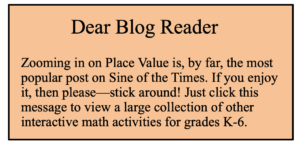One of the aspects I like best about Dynamic Geometry software like Web Sketchpad is its ability to illustrate concepts that cannot effectively be represented with static media. Take, for example, a number line that we draw on a white board. Showing the number line labeled with integers is easy. Adding tenth-mark divisions to the number line isn’t much harder. But beyond tenths, displaying hundredths, thousandths, and beyond is neither simple nor practical unless we have a very long white board. That’s where Web Sketchpad comes to the rescue.
The interactive model below (and here) shows a point sitting on a number line. What is its location? Students might reasonably propose 7.7 or 7.8. After typing their estimate into the box, they press the Zoom button, and watch as the interval between 7 and 8 expands, showing a magnified view divided into ten equal parts (try it!). The point still sits at the same location, but now it lies at a tick mark. What do the tick marks on the second number line represent? Students identify them as tenths and can now name the precise location of the point as 7.8. Pressing New Problem moves the point to a different location (agin, exact in tenths), ready for students to estimate.
To move to the next number-line model, press the arrow in the lower-right corner of the sketch. Again, the goal is to identify a point’s location. The point looks to be at 4.4. When students press Zoom, they’e in for a surprise: The point doesn’t sit at 4.4 or at any of the tenths marks. It’s a little more than 4.4. Perhaps 4.42? To check students press the second Zoom button and yes—the point is indeed at 4.42!
The magnification of the number line continues on the next sketch page where students make three successive predictions of the point’s location. Zooming in on the units number line reveals tenths, zooming in on tenths reveals hundredths, and zooming in on hundredths reveals thousandths.
The final page of the sketch is the most interesting of all. Students make four estimates of the point’s location, but even when they’ve burrowed down to the final number line showing ten thousandths, the point still doesn’t sit a tick mark. Could it be that no matter how many times they zoom in, the point will never lie at a tick mark? This is a great opportunity to introduce students to the notion of irrational numbers.
Finally, be sure to press the Animate button on the last page of the sketch. This button sets the point in motion, and students can analyze how the simultaneous movement of the point along five number lines is related. For example, why does the point move at a glacial pace along the uppermost number line but move ever faster on the number lines below it?
This zooming number line model was inspired by the work of Paul Goldenberg at Education Development Center. Paul’s entire K-5 curriculum, Think Math!, is available for free download.
An annotated list of all our elementary-themed blog posts is here. This list includes an integer version of the zooming number line model.

We are an educational body in Sydney Australia, seeking approval to link to the material above, to provide support for our Maths 7-10 Units of Work.
These units of work are designed to assist teachers and students, as they work with introducing the new Maths 7-10 Syllabus.
Any assistance you can provide in approving our request would be greatly appreciated.
I can forward our Copyright Request Form to you if required.
Stay safe and well.
Steve
Copyright Officer
NSW Education Standards Authority
Hello Steve,
Yes, you may link to my material. I don’t know if you require anything more formal than this message, but if so, please let me know. When everything is in place, I would like to see your materials.
Best,
Daniel Scher